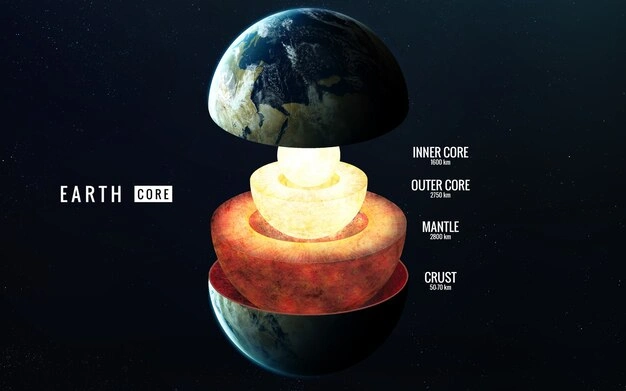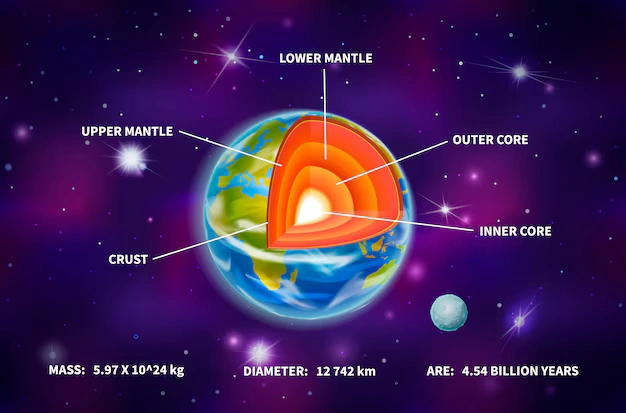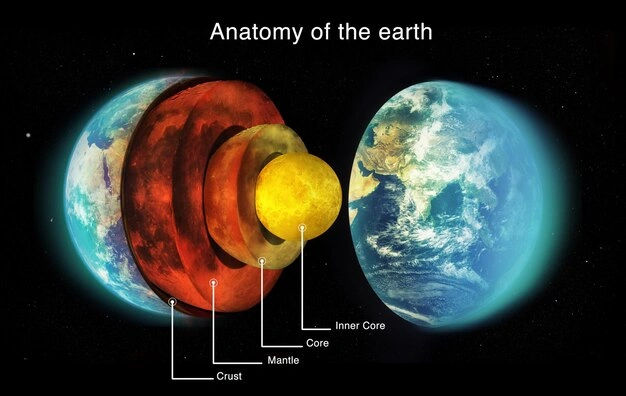Since ancient times, this world has been very much concerned about the Earth’s inner core. This is one of the most inaccessible areas on Earth but hidden in it lies the story of its formation, time of formation, and change in time and the future. New researches have proven that the inner core of Earth is not only stationary but is drastically changing. The latest findings showed that changes were happening within our Earth, and the article holds all the newest scientific research study findings about how and why the Earth’s inner core is changing its shape and what it has in store for our planet.

Knowing the Earth’s Inner Core
To approach the discussion about changes, let’s first talk about what the inner core of Earth is and what it does in the anatomy of our Earth.
What is Earth’s Inner Core?
The inner core is a dense, solid ball of iron and nickel. It is placed at about 5,150 kilometers (3,200 miles) deep inside the crust of the Earth, which is surrounded by the outer core, which is melted as its name indicates. Inner core about the size of Pluto under extreme pressure with temperature ranges as high as 5,700°C or 10,300°F.
Why is Inner Core Important?
It is that part of the Earth, through its movements, produces the earth’s magnetic field known as the geodynamo. Earth’s magnetic field plays a very important role in protection from harmful radiations and cosmic rays and is one of the conditions very important to the maintenance of life on the earth. Behaviour of the inner core controls both the movement of tectonic plates and nature of seismic activities.
How scientists think of the inner core
The inner core is something that cannot be ignored. It is not access-ible internally. So, it can’t be ventured to directly; hence, other means provide the data.
Seismic Waves: Uncover Inner Secrets
The waves of an earthquake travel through Earth’s interior and hold considerable information regarding the core, structure, and composition. Scientists follow this change in velocity and direction during the entire traverse of the core pursuing the properties they might hold.
Computer Simulations and Lab Experiments
The simulated conditions within Earth’s inner core can be ascertained via high-pressure experiments in laboratories combined with highly detailed computer models that can model or simulate those materials’ behavior over those pressures and temperatures.
At first, geoscientists assumed the earth’s inner core was spherical instead of being uneven and sometimes with changes in time.
Evidence That the Inner Core Is Not A Sphere
From the studies using the seismic data, it is shown that waves travel faster in one direction but slower within the inner core in the other two directions. Hence, it is proved that the inner core is not of a uniform structure; that is, it may not necessarily be symmetrical in shape.
What Controls the Changes in the Inner Core?
Changes in the inner core are controlled by many factors.
- Heat Fluxes at the Core-Mantle Boundary: Differential cooling and crystallization ahead of the outer core-mantle boundary introduces an asymmetry into the internal structure due to the heat flux across it.
- Earth Rotation: Introduces forces arising from the Earth’s rotation that eventually alters the inside structure with time
- Gravity Forces: The difference in gravity potential in the Earth also changes the geometrical shape of the inner core.

Impact of Changes in Shape of Inner Core
All modifications in the forms of the inner core affect the entire planet.
Earth’s Magnetic Field
This magnetic field around the earth is formed inside the inner core. Change of the shape of the inner core can cause this power or strength of the magnetic field. With this influence, the solar radiations intensify and by these radiations, it leads to a change or shift of climatic conditions or any technology present in earth.
Effect on Earthquake Activity
The inner core will determine the new pattern of the propagation of seismic waves in the Earth. This may be detrimental to our view inside the earthquakes and how the tectonic plates are moving.
Effects of Knowing the Earth’s History
This change in the inner core gives some suggestions to the scientists about the early past of Earth and how it had changed over millions of years. So, this would eventually give some predictions about what it would be in the future about the planet.
Challenges in Studying the Inner Core
As much as advancement in technology, this is very hard work in studying the inner core.
Only limited data available
It is mainly fragmentary or very ambiguous. It is actually pretty hard to draw any conclusion about the inner core structure.
High Temperature and Pressure
It is very challenging to reproduce the very high pressures and temperatures of the inner core in a laboratory experiment. It somewhat confines the areas of experimental investigations.
Interdisciplinary Study
The entire process is bound to incorporate geophysicists, seismologists, and material scientists. This has made the logistic arrangement even harder.
Future Research Directions
The scientists are inventing new technologies and techniques in studying the inner core.
Advanced Seismic Imaging Future Trends
Information on the internal structure and the chemical composition of the inner core will be presented regarding the progression of the seismic imaging.
High-pressure Experiments
New techniques have made the study even more refined towards greater possible internal core conditions by using a diamond anvil cell.

Space-Based Observations
The satellite and space-based instruments enable this better understanding of how the Earth’s inner core is connected with its magnetic field.
Conclusion
Much is still unknown about this planet, while the core of Earth is dynamic and ever-changing, but much still is shrouded in mystery. New researches have recently found that the inner core of the Earth is asymmetric. The very factors that would drive the development of the inner core of the Earth would be very significant in understanding this kind of development to unravel the mystery of the past, present, and future of Earth.
Exploring this world will give scientists more clues about the forces that shape and hold together in delicate balance to allow life on earth.






GIPHY App Key not set. Please check settings